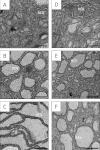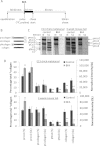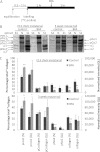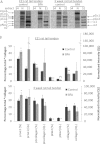Stepwise proteolytic activation of type I procollagen to collagen within the secretory pathway of tendon fibroblasts in situ
- PMID: 21967573
- PMCID: PMC3430002
- DOI: 10.1042/BJ20111379
Stepwise proteolytic activation of type I procollagen to collagen within the secretory pathway of tendon fibroblasts in situ
Abstract
Proteolytic cleavage of procollagen I to collagen I is essential for the formation of collagen fibrils in the extracellular matrix of vertebrate tissues. Procollagen is cleaved by the procollagen N- and C-proteinases, which remove the respective N- and C-propeptides from procollagen. Procollagen processing is initiated within the secretory pathway in tendon fibroblasts, which are adept in assembling an ordered extracellular matrix of collagen fibrils in vivo. It was thought that intracellular processing was restricted to the TGN (trans-Golgi network). In the present study, brefeldin A treatment of tendon explant cultures showed that N-proteinase activity is present in the resulting fused ER (endoplasmic reticulum)-Golgi compartment, but that C-proteinase activity is restricted to the TGN in embryonic chick tendon fibroblasts. In late embryonic and postnatal rat tail and postnatal mouse tail tendon, C-proteinase activity was detected in TGN and pre-TGN compartments. Preventing activation of the procollagen N- and C-proteinases with the furin inhibitor Dec-RVKR-CMK (decanoyl-Arg-Val-Lys-Arg-chloromethylketone) indicated that only a fraction of intracellular procollagen cleavage was mediated by newly activated proteinases. In conclusion, the N-propeptides are removed earlier in the secretory pathway than the C-propeptides. The removal of the C-propeptides in post-Golgi compartments most probably indicates preparation of collagen molecules for fibril formation at the cell-matrix interface.
Figures








Similar articles
-
Surface located procollagen N-propeptides on dermatosparactic collagen fibrils are not cleaved by procollagen N-proteinase and do not inhibit binding of decorin to the fibril surface.J Mol Biol. 1998 Apr 24;278(1):195-204. doi: 10.1006/jmbi.1998.1680. J Mol Biol. 1998. PMID: 9571043
-
Active negative control of collagen fibrillogenesis in vivo. Intracellular cleavage of the type I procollagen propeptides in tendon fibroblasts without intracellular fibrils.J Biol Chem. 2008 May 2;283(18):12129-35. doi: 10.1074/jbc.M708198200. Epub 2008 Feb 19. J Biol Chem. 2008. PMID: 18285337
-
Formation of collagen fibrils in vitro by cleavage of procollagen with procollagen proteinases.J Biol Chem. 1982 Jul 25;257(14):8442-8. J Biol Chem. 1982. PMID: 6806297
-
Enzymes converting procollagens to collagens.J Cell Biochem. 1985;28(1):15-21. doi: 10.1002/jcb.240280104. J Cell Biochem. 1985. PMID: 3928635 Review.
-
Procollagen N-proteinase and procollagen C-proteinase. Two unusual metalloproteinases that are essential for procollagen processing probably have important roles in development and cell signaling.Matrix Biol. 1998 Feb;16(7):399-408. doi: 10.1016/s0945-053x(98)90013-0. Matrix Biol. 1998. PMID: 9524360 Review.
Cited by
-
Molecular mechanisms and clinical manifestations of rare genetic disorders associated with type I collagen.Intractable Rare Dis Res. 2019 May;8(2):98-107. doi: 10.5582/irdr.2019.01064. Intractable Rare Dis Res. 2019. PMID: 31218159 Free PMC article. Review.
-
p-Coumaric Acid Attenuates UVB-Induced Release of Stratifin from Keratinocytes and Indirectly Regulates Matrix Metalloproteinase 1 Release from Fibroblasts.Korean J Physiol Pharmacol. 2015 May;19(3):241-7. doi: 10.4196/kjpp.2015.19.3.241. Epub 2015 Apr 30. Korean J Physiol Pharmacol. 2015. PMID: 25954129 Free PMC article.
-
Visualized procollagen Iα1 demonstrates the intracellular processing of propeptides.Life Sci Alliance. 2022 Feb 18;5(5):e202101060. doi: 10.26508/lsa.202101060. Print 2022 May. Life Sci Alliance. 2022. PMID: 35181633 Free PMC article.
-
The proprotein convertase BLI-4 promotes collagen secretion prior to assembly of the Caenorhabditis elegans cuticle.PLoS Genet. 2023 Sep 18;19(9):e1010944. doi: 10.1371/journal.pgen.1010944. eCollection 2023 Sep. PLoS Genet. 2023. PMID: 37721936 Free PMC article.
-
Towards understanding the dose and timing effect of hydrocortisone treatment on the scleral ossicle system within the chicken eye.J Anat. 2018 Feb;232(2):270-282. doi: 10.1111/joa.12744. Epub 2017 Dec 6. J Anat. 2018. PMID: 29210090 Free PMC article.
References
-
- Chapman J. A., Tzaphlidou M., Meek K. M., Kadler K. E. The collagen fibril: a model system for studying the staining and fixation of a protein. Electron Microsc. Rev. 1990;3:143–182. - PubMed
-
- Kadler K. E., Hojima Y., Prockop D. J. Assembly of collagen fibrils de novo by cleavage of the type I pC-collagen with procollagen C-proteinase: assay of critical concentration demonstrates that collagen self-assembly is a classical example of an entropy-driven process. J. Biol. Chem. 1987;262:15696–15701. - PubMed
-
- Bonfanti L., Mironov A. A., Martinez-Menarguez J. A., Martella O., Fusella A., Baldassarre M., Buccione R., Geuze H. J., Luini A. Procollagen traverses the Golgi stack without leaving the lumen of cisternae: evidence for cisternal maturation. Cell. 1998;95:993–1003. - PubMed
Publication types
MeSH terms
Substances
Grants and funding
LinkOut - more resources
Full Text Sources
Molecular Biology Databases
Research Materials
Miscellaneous

